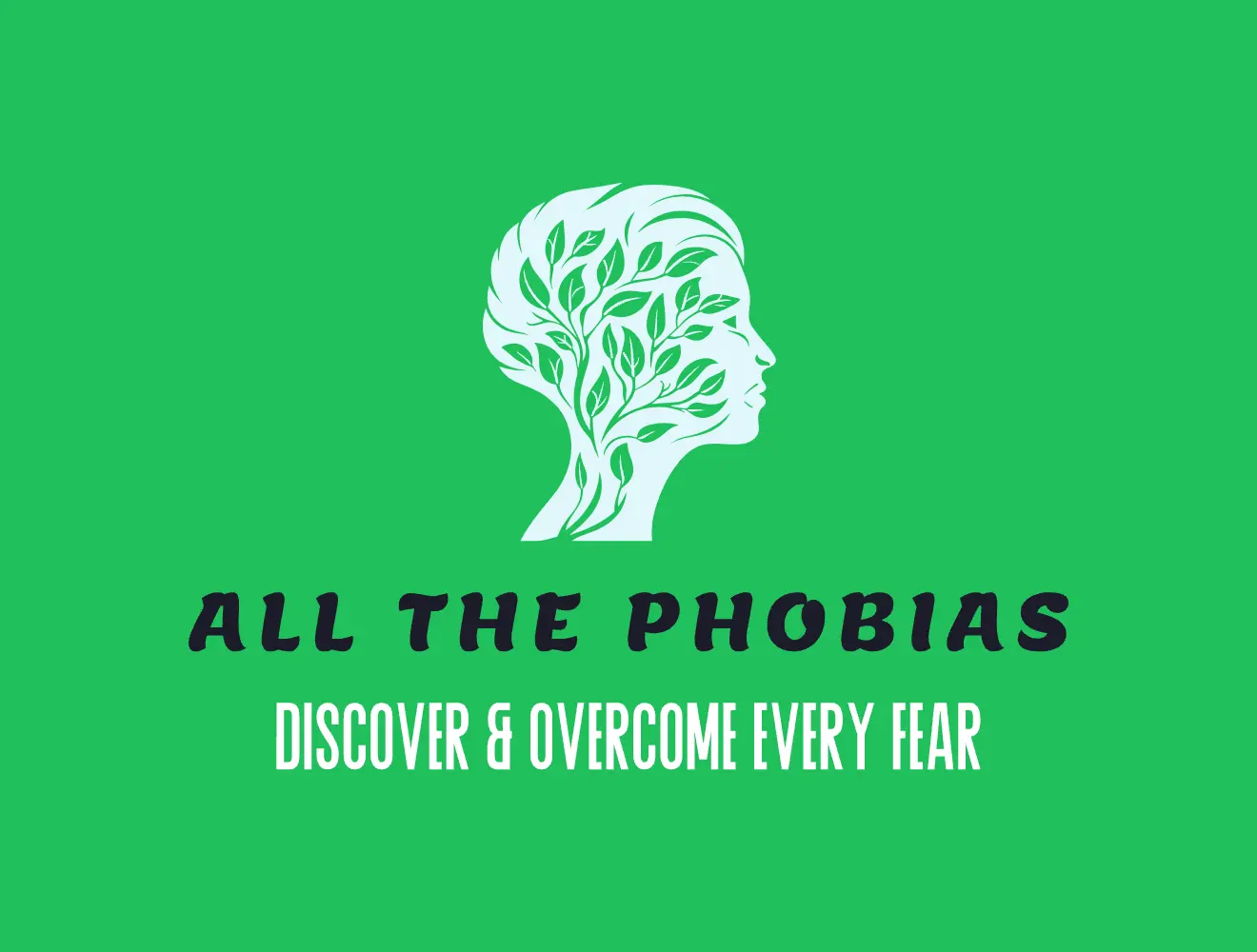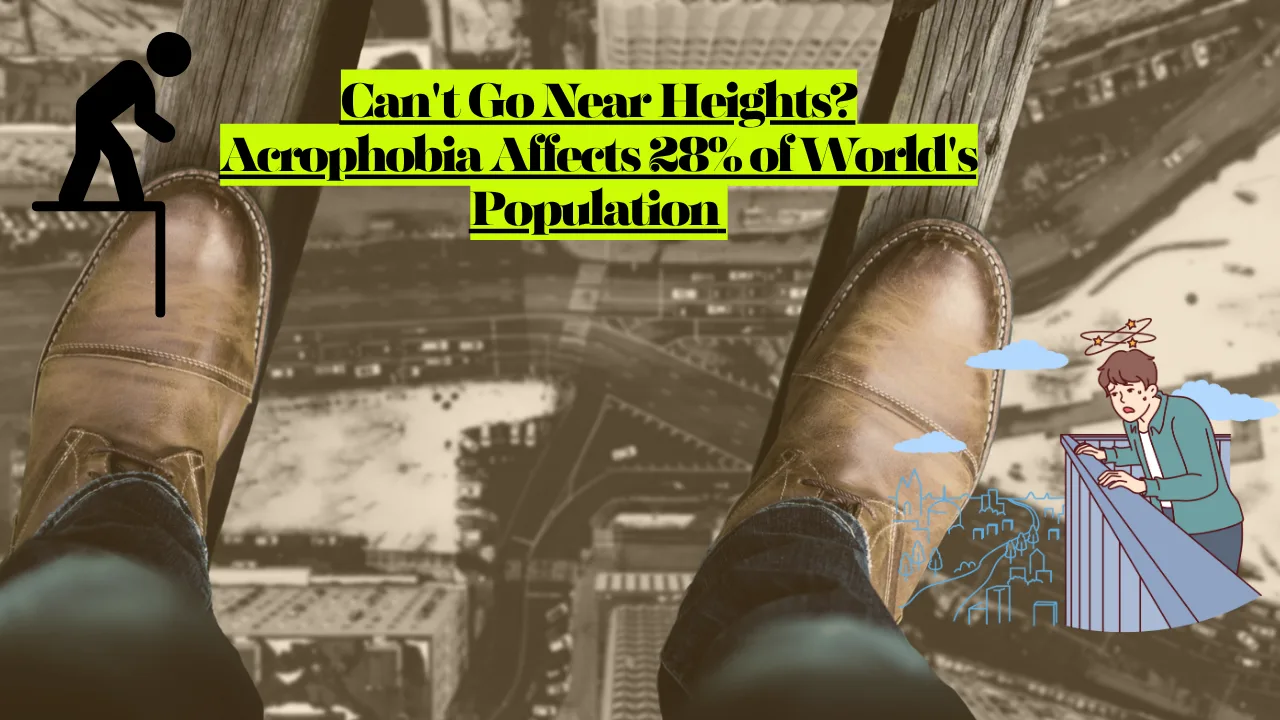Acrophobia is an intense, persistent fear of heights that goes far beyond normal caution around high places. If you experience overwhelming anxiety when looking down from a balcony, feel dizzy on a ladder, or avoid situations involving heights altogether, you’re likely dealing with this specific phobia.
Here’s what you need to know right away:
It affects approximately 28% of adults (with visual height intolerance including acrophobia), though severe acrophobia specifically impacts 2-5% of the general population. Women are affected twice as often as men, and this is a recognized psychological condition listed in the DSM-5, not simply “being scared” of heights.
Research has shown that exposure therapy, especially virtual reality exposure therapy, is successful in treating acrophobia. Meta-analyses have shown that exposure-based treatments, particularly those based on cognitive-behavioral therapy (CBT), are the most effective and durable interventions for specific phobias.
The encouraging news is that effective treatments exist with proven success rates, and you can overcome this fear with the right approach. At AllThePhobias.com, we’ve compiled the most current research and professional insights to help you understand and address acrophobia.
Do You Have Acrophobia? Key Signs to Look For
Physical Symptoms When Encountering Heights:
When exposed to heights or even thinking about high places, your body may respond with:
- Intense dizziness or vertigo – feeling like the world is spinning
- Rapid heartbeat (tachycardia) – your heart pounds noticeably faster
- Shortness of breath – feeling like you can’t get enough air
- Excessive sweating – particularly on palms and forehead
- Nausea or stomach upset – sometimes leading to vomiting
- Trembling or shaking – especially in hands and legs
These physical responses occur because your nervous system activates the “fight-or-flight” response, preparing your body for perceived danger (American Anxiety and Depression Association).
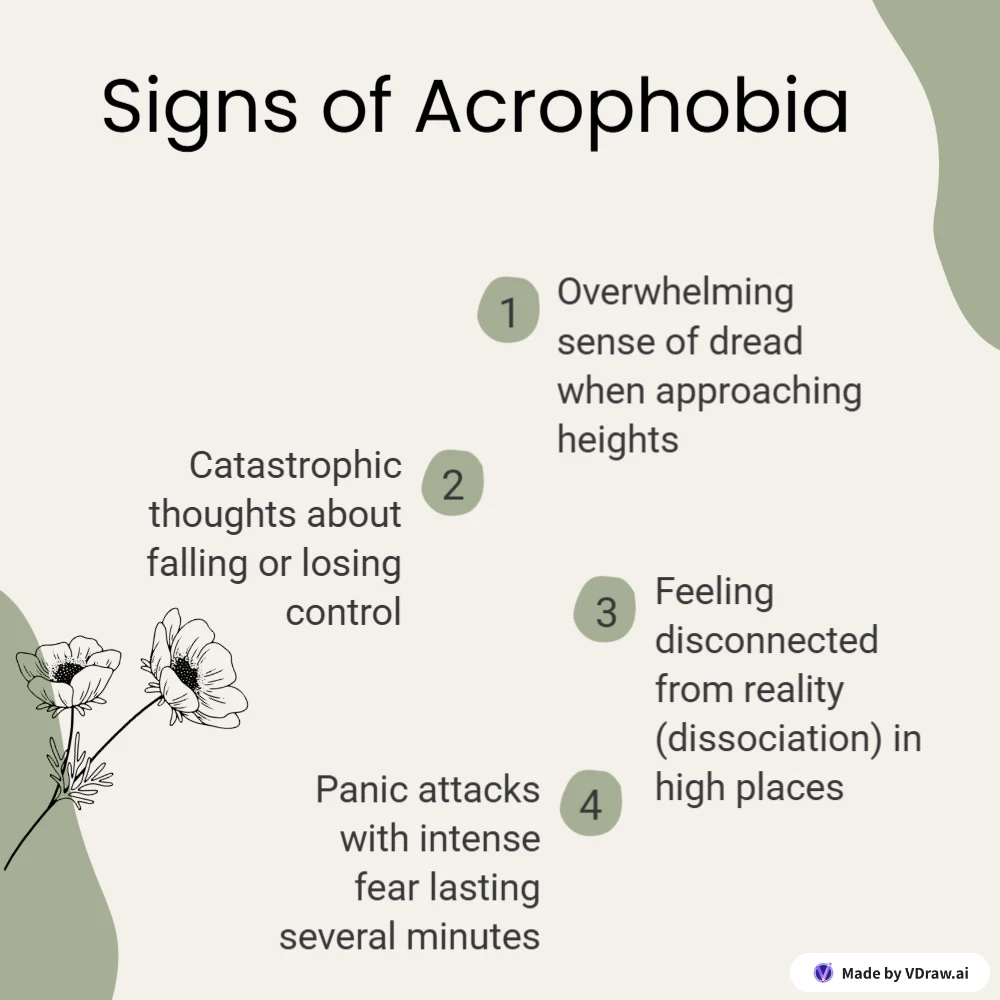
Emotional & Mental Responses:
- Overwhelming sense of dread when approaching heights
- Catastrophic thoughts about falling or losing control
- Feeling disconnected from reality (dissociation) in high places
- Panic attacks with intense fear lasting several minutes
- Anticipatory anxiety – worrying about future encounters with heights
Behavioral Changes:
- Active avoidance of tall buildings, bridges, balconies, or ladders
- Route planning around avoiding highways with high overpasses
- Career limitations – avoiding jobs that might involve heights
- Travel restrictions – difficulty with flights or staying in high hotel floors
- Social isolation – declining invitations to events in high places
When your fear becomes so intense that it significantly impacts your daily functioning, relationships, or career, it has reached clinical significance and warrants professional attention.
Comprehensive Triggers & Situations
All Major Triggers:
Natural High Places:
- Mountain viewpoints, cliffs, canyons, and coastal overlooks
- Hiking trails with drop-offs and elevated outdoor platforms
Built Environment Triggers:
- Multi-story buildings and skyscrapers
- Balconies, terraces, rooftops, and fire escapes
- Bridges, overpasses, and elevated highways
- Glass elevators and observation decks
- Stadium upper levels and parking garage upper floors
Transportation-Related Heights:
- Commercial airline flights (especially window seats)
- Ferris wheels, roller coasters, cable cars, and chairlifts
- High-rise hotel rooms above the third floor
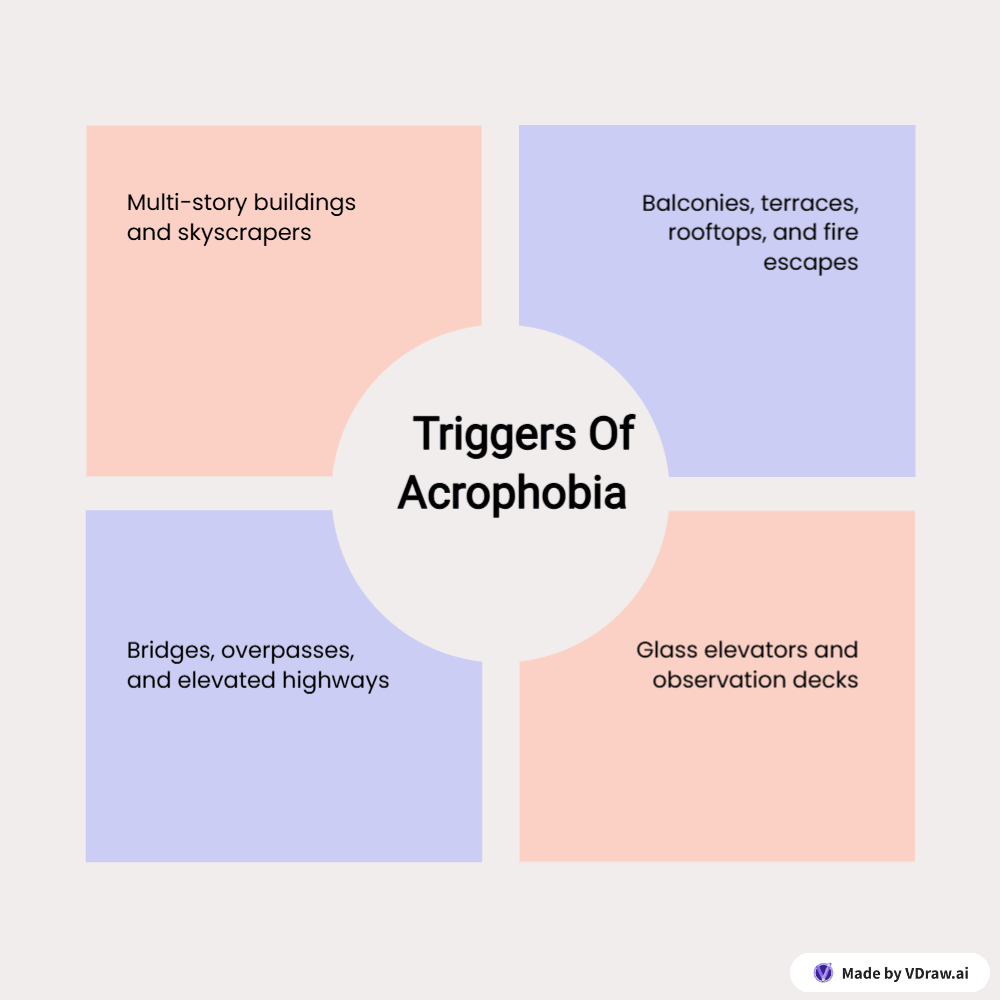
Modern Digital Triggers:
- Virtual Reality experiences with height simulations
- Social media content showing extreme heights
- Action movies with scenes involving heights or falling
- Video games with first-person height scenarios
Severity Levels:
Mild Triggers: Second-floor windows, short stepladders Moderate Triggers: Fourth to tenth-floor buildings, highway overpasses Severe Triggers: Anything above ten stories, glass-bottomed platforms, cliff edges
Understanding Acrophobia: The Science Behind Your Fear
What Causes This Fear?
The Neurological Mechanisms: Your brain processes height-related fear through interconnected systems. The amygdala (your brain’s alarm system) immediately detects potential threats from heights and triggers fight-or-flight responses. Recent research using EEG patterns in young adults exposed to different acrophobia levels achieved 73% accuracy in fear detection, showing measurable brain activity differences in people with acrophobia.
Evolutionary Explanations: From an evolutionary perspective, some fear of heights likely provided survival advantages to our ancestors. However, epidemiological studies revealed a lifetime prevalence of visual height intolerance including acrophobia in 28% of adults (32% in women; 25% in men) and 34% among prepubertal children aged 8-10 years.
Development Patterns:
Learned Responses: Many people develop acrophobia through associative learning from frightening falls or witnessing others fall from height.
Trauma-Related Origins: Direct traumatic experiences involving heights can trigger acrophobia development. Visual height intolerance first occurring in adulthood usually has different characteristics from childhood-onset acrophobia, often involving specific triggering events.
How It Differs From Normal Fear:
Clinical Diagnostic Criteria (DSM-5):
- An unreasonable, intense fear out of proportion to actual danger
- Anticipatory anxiety and persistent dread
- Active avoidance of height situations
- Significant interference with daily life for six months or longer
5 MYTHS vs. REALITY
Myth #1: “Acrophobia is just being scared of heights—everyone has it”
Reality: While 28% experience height discomfort, severe acrophobia (2-5%) causes panic attacks and life disruption. Normal caution doesn’t prevent you from using stairs or working in tall buildings.
Myth #2: “If you have acrophobia, you’ll never be able to fly or visit tall buildings”
Reality: 80-90% of people successfully overcome acrophobia with treatment. Many go on to enjoy air travel, hiking, and careers in high-rise buildings after completing therapy.
Myth #3: “Acrophobia means you have weak balance or vestibular problems”
Reality: Acrophobia is primarily a psychological fear response, not a physical balance disorder. Your brain misinterprets visual-vestibular signals as threatening, triggering anxiety—not actual instability.
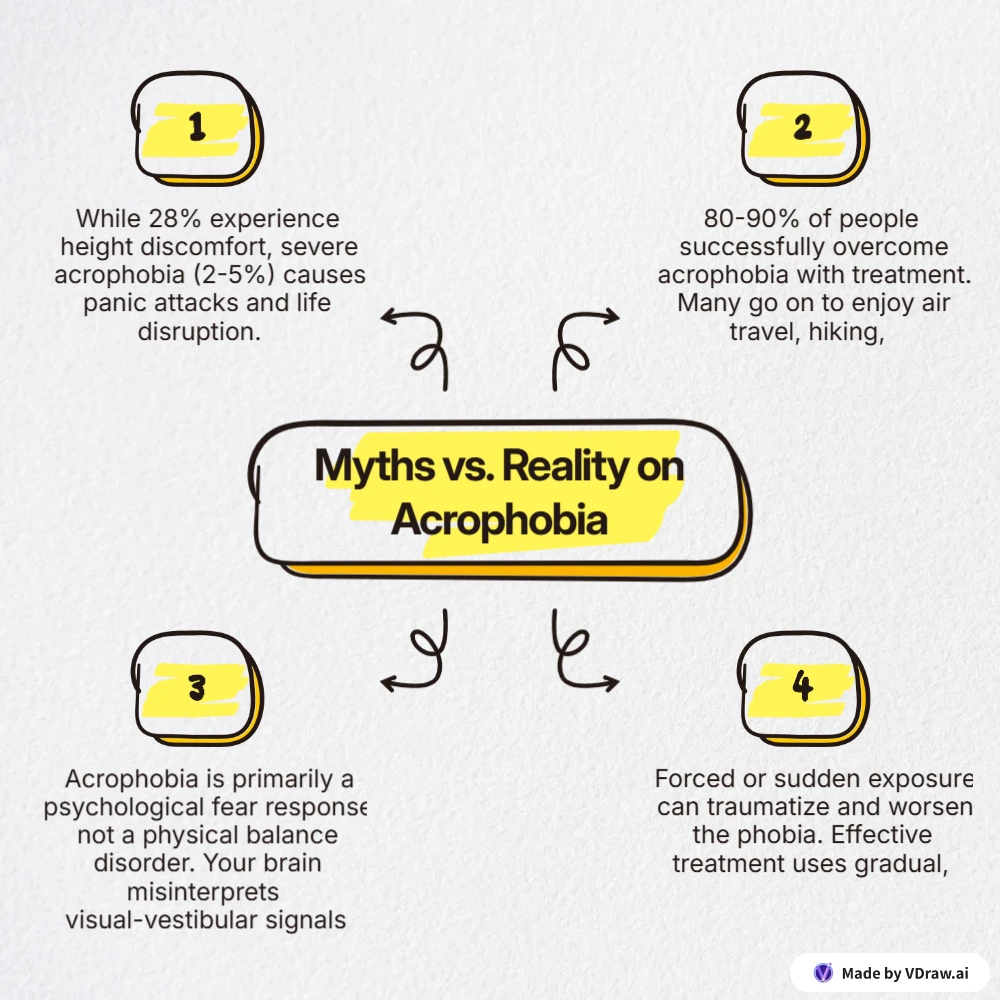
Myth #4: “You just need to face your fear suddenly to get over it”
Reality: Forced or sudden exposure can traumatize and worsen the phobia. Effective treatment uses gradual, controlled exposure over 8-16 sessions with professional guidance and coping strategies.
Myth #5: “Acrophobia only affects your personal life, not your career”
Reality: Untreated acrophobia limits career opportunities in construction, aviation, architecture, emergency services, and even office jobs in high-rise buildings. It can prevent promotions and job changes.
Real-World Impact & Life Challenges
Consider Maria, a talented architect, who discovered her acrophobia was limiting her career when she couldn’t conduct site visits to construction projects above the third floor. After seeking cognitive-behavioral therapy and completing a specialized exposure therapy program, she developed practical coping strategies that allowed her to manage her fear while advancing in her profession.
Common Life Areas Affected:
Work and Career: Many jobs require occasional exposure to heights – from office meetings in high-rise buildings to construction and telecommunications work. People who have acrophobia and don’t seek treatment are two times more likely to develop a generalized anxiety disorder.
Relationships and Social Life: Acrophobia can strain relationships when you consistently decline social invitations involving heights – rooftop bars, scenic hikes, or vacation destinations.
Daily Tasks: Simple household tasks become major challenges. Changing smoke detector batteries, decorating for holidays, or accessing attic storage can trigger panic responses.
Emergency Preparedness: Acrophobia can complicate emergency situations where you might need to evacuate from upper floors or help someone in a high place.
Treatment & Recovery Options
Professional Treatment (Most Effective):
Cognitive Behavioral Therapy (CBT): Meta-analyses have shown that exposure-based treatments, particularly those based on cognitive-behavioral therapy (CBT), are the most effective and durable interventions for specific phobias. Success rates for CBT in treating specific phobias like acrophobia range from 80-90% when patients complete the full treatment program.
CBT works by helping you identify and change thought patterns that maintain your fear. Treatment typically involves 12-16 weekly sessions with measurable progress usually beginning within 4-6 weeks.
Exposure Therapy: Research has shown that exposure therapy, especially virtual reality exposure therapy, is successful in treating acrophobia. The process starts with less threatening exposures and progressively works toward more challenging situations.
Recent randomized controlled trials show significant efficacy of virtual reality exposure therapy on symptoms of acrophobia and anxiety sensitivity in adolescent girls. VRET allows you to experience realistic height situations in a completely safe environment.
Other Professional Options:
- EMDR for trauma-related acrophobia
- Medication as adjunct treatment (anti-anxiety medications, beta-blockers)
- Combined approaches using multiple treatment methods
Self-Help Strategies:
Breathing Techniques: The 4-7-8 technique can interrupt panic responses Grounding Exercises: The 5-4-3-2-1 technique helps maintain present-moment awareness Gradual Self-Exposure: Start with height-related images, progress slowly with safety guidelines Lifestyle Modifications: Regular exercise, adequate sleep, limiting caffeine
When to Seek Professional Help:
Only about 10% to 25% of people who have a specific phobia, such as acrophobia, seek treatment for their condition because many can avoid the situation that they fear. However, consider professional help if your fear prevents normal activities, causes panic attacks, or affects relationships and career opportunities.
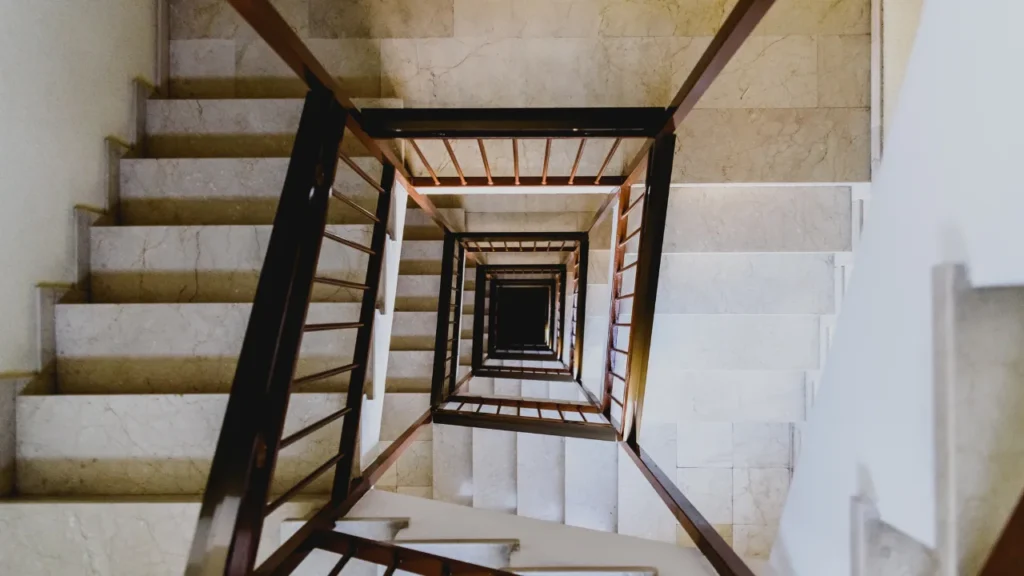
Immediate Coping Strategies & Resources
Emergency Coping Techniques:
4-7-8 Breathing: Inhale for 4 seconds, hold for 7 seconds, exhale for 8 seconds 5-4-3-2-1 Grounding: Name 5 things you see, 4 you can touch, 3 you hear, 2 you smell, 1 you taste Progressive Muscle Relaxation: Tense and release muscle groups systematically Safe Space Visualization: Create a detailed mental image of a completely safe place
Helpful Resources:
Crisis Hotlines:
- National Suicide Prevention Lifeline: 988
- Crisis Text Line: Text HOME to 741741
- SAMHSA National Helpline: 1-800-662-HELP (4357)
Mobile Apps:
- DARE app for anxiety and panic attacks
- Headspace for anxiety-focused meditations
- Calm for breathing exercises and panic support
When to Seek Immediate Help:
- Thoughts of self-harm
- Multiple panic attacks per week
- Complete inability to function daily
- Using substances to manage anxiety
Test Yourself: Do You Have Acrophobia?
Quick Self-Assessment Tool
Rate each statement from 1 (never) to 5 (always):
Physical Response Questions:
- I feel dizzy or nauseous when looking down from heights
- My heart races when I’m on balconies or upper floors
- I experience sweating or trembling near edges of high places
- I feel like I might faint when exposed to height situations
Behavioral Questions: 5. I avoid tall buildings, bridges, or elevated areas 6. I refuse job opportunities that might involve heights 7. I plan routes to avoid high overpasses or elevated roads 8. I decline social invitations to rooftop venues or high locations
Severity Scoring:
- 8-16 points: Mild height sensitivity (normal caution)
- 17-28 points: Moderate acrophobia (consider professional consultation)
- 29-40 points: Severe acrophobia (professional treatment recommended)
This self-assessment is for informational purposes only and doesn’t replace professional diagnosis. If you scored in the moderate to severe range, consider speaking with a mental health professional.
The Connection Between Acrophobia and Other Conditions
Comorbid Disorders Often Found With Acrophobia:
Research shows that acrophobia is highly associated with the tendency to interpret ambiguous bodily sensations as threatening, creating links with other anxiety disorders:
Agoraphobia: Both involve fear of situations where escape might be difficult. Many people with acrophobia also develop agoraphobia, particularly regarding open spaces or crowded areas.
Panic Disorder: The physical sensations experienced during height exposure can trigger panic attacks, which may then occur in other situations.
Vestibular Disorders: People tend to wrongly interpret visuo-vestibular discrepancies as dizziness and nausea and associate them with a forthcoming fall, creating a cycle where balance issues worsen height fear.
Generalized Anxiety Disorder: Untreated acrophobia often evolves into broader anxiety patterns, with worry extending beyond height situations.
Age-Specific Considerations
Acrophobia in Children (Ages 5-12):
- Often develops after falls or scary height experiences during play
- May manifest as refusal to use playground equipment or climb stairs
- Treatment focuses on gradual play-based exposure and parent education
- Many childhood cases resolve naturally with proper support
Acrophobia in Teenagers (Ages 13-18):
- Can intensify during puberty due to hormonal changes and brain development
- Often affects social activities like amusement parks or hiking with friends
- May impact academic performance if school has multi-story buildings
- Virtual reality treatment shows particular success in this age group
Acrophobia in Seniors (Ages 65+):
- May worsen due to decreased balance confidence and vision changes
- Increased fall risk creates legitimate safety concerns that complicate treatment
- Often connected to broader aging anxieties and independence concerns
- Treatment must account for physical limitations and medication interactions
Industry-Specific Impacts and Accommodations
Construction and Trades:
- OSHA requires safety equipment, but acrophobia may still prevent work performance
- Alternative career paths: ground-level specializations, project management, equipment operation
- Some workers successfully use gradual exposure therapy while maintaining safety protocols
Aviation Industry:
- Flight attendants and pilots cannot have untreated severe acrophobia
- Air traffic controllers in tower positions may be affected
- Treatment success rates are high when career motivation is strong
Architecture and Engineering:
- Site visits to construction projects require height tolerance
- Many professionals adapt by using technology (drones, ground-level assessments)
- Career specialization can focus on design rather than on-site supervision
Emergency Services:
- Firefighters and rescue workers must be comfortable with ladder and aerial work
- Police officers may need to access multi-story buildings
- Pre-employment screening often includes height tolerance assessment
Frequently Asked Questions
Is acrophobia a real mental health condition?
Yes, acrophobia is a recognized specific phobia listed in the DSM-5. It’s a medical condition, not simply “being scared” of heights.
How common is acrophobia?
Epidemiological studies revealed a lifetime prevalence of visual height intolerance including acrophobia in 28% of adults (32% in women; 25% in men). Severe acrophobia affects approximately 2-5% of the population.
Can acrophobia be cured?
While “cured” suggests complete elimination, acrophobia can be successfully treated with 80-90% success rates for people who complete evidence-based treatment programs.
How long does treatment take?
CBT typically involves 12-16 weekly sessions, while exposure therapy may require 8-12 sessions. Improvement often begins within 4-6 weeks.
Can children have acrophobia?
Research shows 34% of prepubertal children aged 8-10 years experience visual height intolerance without gender preponderance. Many children naturally outgrow height fears, but persistent cases may require treatment.
Will I pass this fear to my children?
There may be both genetic and environmental factors. Being aware allows you to take preventive steps while getting treatment for yourself.
What should I do during a panic attack?
Get to a safe location, use 4-7-8 breathing, practice grounding techniques, and remind yourself that panic attacks are temporary and won’t harm you.
Risk Factors:
- Comorbidity risk: People with untreated acrophobia are 2x more likely to develop generalized anxiety disorder
- Gender factor: Women affected twice as often as men
- Age factors: Adult-onset acrophobia has different characteristics than childhood-onset
Citations & Sources
- Huppert, D., Grill, E., & Brandt, T. (2017). A new questionnaire for estimating the severity of visual height intolerance and acrophobia by a metric interval scale. Frontiers in Neurology, 8, 211.
- Wolitzky-Taylor, K. B., Horowitz, J. D., Powers, M. B., & Telch, M. J. (2008). Psychological approaches in the treatment of specific phobias: A meta-analysis. Clinical Psychology Review, 28(6), 1021-1037.
- Park, G. J., Kim, H. E., Lim, S. M., Lee, Y. K., & Kim, J. J. (2019). Brain substrates of recovery from fear: A systematic review and meta-analysis of fMRI studies on extinction learning and exposure therapy. Neuroscience & Biobehavioral Reviews, 105, 60-72.
- Shiban, Y., Pauli, P., & Mühlberger, A. (2013). Effect of multiple context exposure on renewal in spider phobia. Behaviour Research and Therapy, 51(2), 68-74.
- Kessler, R. C., Chiu, W. T., Demler, O., & Walters, E. E. (2005). Prevalence, severity, and comorbidity of 12-month DSM-IV disorders in the National Comorbidity Survey Replication. Archives of General Psychiatry, 62(6), 617-627.
- American Psychiatric Association. (2013). Diagnostic and statistical manual of mental disorders (5th ed.). Arlington, VA: American Psychiatric Publishing.
- Anxiety and Depression Association of America. (2021). Facts & Statistics. Retrieved from https://adaa.org/understanding-anxiety/facts-statistics
- Freeman, D., Haselton, P., Freeman, J., Spanlang, B., Kishore, S., Albery, E., … & Nickless, A. (2018). Automated psychological therapy using immersive virtual reality for treatment of fear of heights: A single-blind, parallel-group, randomised controlled trial. The Lancet Psychiatry, 5(8), 625-632.
- National Institute of Mental Health. (2022). Specific Phobia. Retrieved from https://www.nimh.nih.gov/health/statistics/specific-phobia
